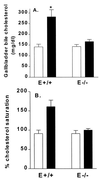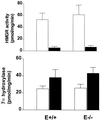Apolipoprotein E regulates dietary cholesterol absorption and biliary cholesterol excretion: studies in C57BL/6 apolipoprotein E knockout mice
- PMID: 10725355
- PMCID: PMC16257
- DOI: 10.1073/pnas.97.7.3433
Apolipoprotein E regulates dietary cholesterol absorption and biliary cholesterol excretion: studies in C57BL/6 apolipoprotein E knockout mice
Abstract
The present study examined the role of apolipoprotein E (apoE) in the regulation of dietary cholesterol absorption and biliary cholesterol excretion. Increasing dietary cholesterol from 0.02% to 0.5% in C57BL/6 wild-type mice decreased the percentage of dietary cholesterol that is absorbed by 25%, and this decrease was associated with a 2-fold increase in gallbladder biliary cholesterol concentration. In contrast, increasing dietary cholesterol from 0. 02% to 0.5% in C57BL/6 apoE knockout mice produced no significant suppression of the percentage dietary cholesterol absorption and increased gallbladder biliary cholesterol concentration only 16%. Whereas in wild-type mice, the increase in dietary cholesterol increased the hepatic excretion of biliary cholesterol 4-fold, there was only a 2-fold increase in apoE knockout mice. On both the low- and the high-cholesterol diets, whole liver and isolated hepatocyte cholesterol content was higher in the apoE knockout mice. These results suggest that, in response to dietary cholesterol, apoE may play a critical role in decreasing the percentage absorption of dietary cholesterol and increasing biliary cholesterol excretion. These observations suggest a mechanism whereby the absence of apoE contributes to the propensity for tissue cholesterol deposition and accelerated atherogenesis in apoE knockout mice.
Figures




Similar articles
-
Impaired biliary cholesterol secretion and decreased gallstone formation in apolipoprotein E-deficient mice fed a high-cholesterol diet.Gastroenterology. 2000 Apr;118(4):772-9. doi: 10.1016/s0016-5085(00)70147-8. Gastroenterology. 2000. PMID: 10734029
-
Apolipoprotein E competitively inhibits receptor-dependent low density lipoprotein uptake by the liver but has no effect on cholesterol absorption or synthesis in the mouse.Proc Natl Acad Sci U S A. 1995 Dec 19;92(26):12500-4. doi: 10.1073/pnas.92.26.12500. Proc Natl Acad Sci U S A. 1995. PMID: 8618929 Free PMC article.
-
Biliary cholesterol excretion: a novel mechanism that regulates dietary cholesterol absorption.Proc Natl Acad Sci U S A. 1998 Aug 18;95(17):10194-9. doi: 10.1073/pnas.95.17.10194. Proc Natl Acad Sci U S A. 1998. PMID: 9707623 Free PMC article.
-
Regulation of the apolipoprotein E by dietary lipids occurs by transcriptional and post-transcriptional mechanisms.Mol Cell Biochem. 1996 Feb 23;155(2):153-62. doi: 10.1007/BF00229312. Mol Cell Biochem. 1996. PMID: 8700160
-
The value of apolipoprotein E knockout mice for studying the effects of dietary fat and cholesterol on atherogenesis.Curr Opin Lipidol. 2000 Feb;11(1):25-9. doi: 10.1097/00041433-200002000-00004. Curr Opin Lipidol. 2000. PMID: 10750690 Review.
Cited by
-
Effects of Six Weeks of Hypoxia Exposure on Hepatic Fatty Acid Metabolism in ApoE Knockout Mice Fed a High-Fat Diet.Life (Basel). 2022 Oct 1;12(10):1535. doi: 10.3390/life12101535. Life (Basel). 2022. PMID: 36294970 Free PMC article.
-
A 3-week nonalcoholic steatohepatitis mouse model shows elafibranor benefits on hepatic inflammation and cell death.Clin Transl Sci. 2020 May;13(3):529-538. doi: 10.1111/cts.12735. Epub 2020 Jan 25. Clin Transl Sci. 2020. PMID: 31981449 Free PMC article.
-
Monoglyceride lipase deficiency affects hepatic cholesterol metabolism and lipid-dependent gut transit in ApoE-/- mice.Oncotarget. 2017 May 16;8(20):33122-33136. doi: 10.18632/oncotarget.16529. Oncotarget. 2017. PMID: 28380440 Free PMC article.
-
The association between apolipoprotein E and gallstone disease: an updated meta-analysis.BMC Med Genet. 2019 Jun 14;20(1):109. doi: 10.1186/s12881-019-0843-6. BMC Med Genet. 2019. PMID: 31200656 Free PMC article.
-
Blue-Green Algae Inhibit the Development of Atherosclerotic Lesions in Apolipoprotein E Knockout Mice.J Med Food. 2015 Dec;18(12):1299-306. doi: 10.1089/jmf.2015.0025. Epub 2015 Nov 13. J Med Food. 2015. PMID: 26566121 Free PMC article.
References
Publication types
MeSH terms
Substances
Grants and funding
LinkOut - more resources
Full Text Sources
Medical
Molecular Biology Databases
Miscellaneous

